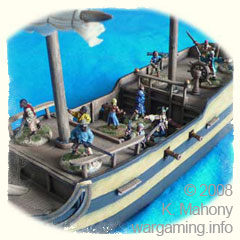
Avast! Ye Lubbers and Bilge Rats! Be here the means and way to use the contents of ye bung hole to build ye very owne brigantine pirate ship! Arrr!
A while ago one of my main gaming opponents, and Auckland Wargaming Club member, Kieran Mahony built himself a Pirate Ship for use with 28mm Pirate Figures playing GW’s “Legends Of The High Seas” (LOTHS) rules. Kieran originally published this article on his 6mm Wargaming website in 2008, but as that website is not necessarily the best place for an article about 28mm figures and scratch building a 28mm scale Pirate Ship I’ve decided to host Kieran’s article here to hopefully give it a wider audience!
Introduction
This pirate ship is based on the model by Gary Chalk from Wargames Illustrated Magazine (#138), “How to scratchbuild Brigantines from card and wood“, it was also available on the Wargames Foundry website as a PDF download (but now does not appear to be available any longer). [Editor’s Note: We now have the PDF available here – see part two of this article].
I decided to use some different materials such as foamboard and plasticard instead of balsa. This was mainly because it’s what I had lying around and I like the look of the plastic card for the decks instead of balsa (generally I’ve found it hard to get balsa to come out looking good).
I made the model slightly longer but that was because of how it came out after I broke the image into two halves and printed it on to 2 pieces of A4 paper, and then joined it together.
Materials Used
- 5mm Foamboard
- PVA (White) glue
- 5mm Balsa wood
- HO wood planking Plasticard from Plastruct
- Thin card (from cereal packets or similar)
- 3mm thick Balsa wood strips or sheets
- Wooden Coffee stirrer
- Poster board pins
- 4mm, 6mm and 8mm Dowel
- 0.5mm Plasticard
- Exacto Blade tube
- Fine mesh
- 1.5mm Cardboard
- Cloth for the sails
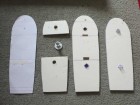
The Main Hull Sections
Photo 1 is the initial deck that I cut out using the templates and a Eureka 28mm figure for comparison. To hold up the masts I used a couple of old plastic tubes that the Exacto knife blades come in. I cut them up and used part of the tubes in the hole in each deck section. The bottom part I glued to the base section. I did this because I wanted the mast to be removable for carrying.
I also decided to make the doors slightly lower than the deck so I had to cut some steps out of the foamboard.
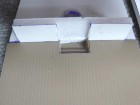
Plasticard Deck
I measured it using the original templates and cut it up using some scissors. The card is pretty thin and easy to cut and the detail is good. I also gave it a light sand to add a bit more texture to the wood grain. I also used the off cuts for the steps down to the doors.
I’ve also glued the bulkheads on to the hull sections and added some reinforcing. I used foamboard off cuts to help reinforce the joints.
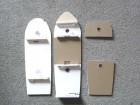
The Bulkheads
The bulkheads were slightly lower than the plans as I had to allow for the thicker foamboard I used for the hull sections. You can also see the recesses for the doors and the details on the steps (Photo 3).
Front And Rear Parts
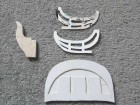
The diagram was a bit confusing for the rear before I realised there was 2 pieces! After I glued those together I used some modelling putty to try and smooth the gaps. The front piece was made from 5mm balsa wood and I copied it from the design but made it as bit taller.
The decorative parts are made from thin card and the details cut out with a modelling knife (Photo 4).
Decking Details

I got out my dremel and scribed the deck so it looks like there are planks and not just continuous strips of wood. As you can see from Photo 5 I went a bit crooked on some of them! Also you can see the hatch that I made from some plastic mesh that I had, (I think it’s from an old 1/35th model) and the edges are from 0.5mm plastic card.
Also the rear quarter and front bow have been glued onto the model.
The Sections
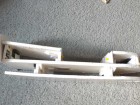
In Photo 6 you can see how the different layers are glued together and the reinforcing that has been added. I used PVA to glue it all together and more PVA in the joints once the glue had set.
The Sides
I wanted to make them a bit sturdier so I decided to layer the thin card, with each layer smaller than the last. I also like the look of the layers as it helped break up the flat side and it also looks more like planks (Photo 7).
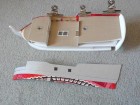
The Front
At the front I stuffed up the measurements on the hull sides so I will need to fill the gap around the prow with some more cardboard. At the time I hoped the decorative parts will cover most of this so I can use some pieces of balsa to hide the bad joins.
The Second Side
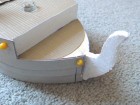
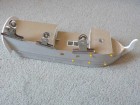
For this side I found it much easier to glue all 3 layers together and then glue it onto the ship. The cardboard is pretty thin so I curved it to fit the side of the boat before the glue dried completely.
Read On with Arrr! A Buxom Beauty: A Pirate Ship in 28mm [Part 2].
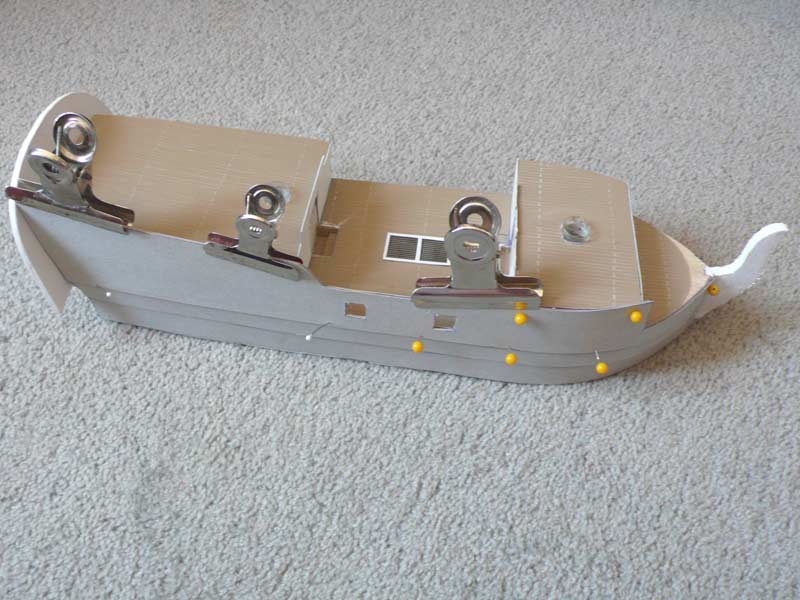
Thanks for posting this. I’m about to start my own go at the Chalk plans myself, and this post provides a lot of useful guidance.